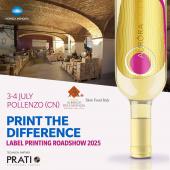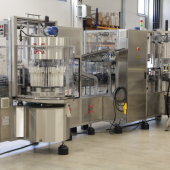Sensors & security - Ideas from SPS IPC Drives Italia
Automation for the digital and flexible industry on show at SPS: discovering the trends that are guiding development and production. Review of solutions dedicated to the world of packaging, with a first focus on the evolution of sensors. First part.
By Maurizio Cacciamani
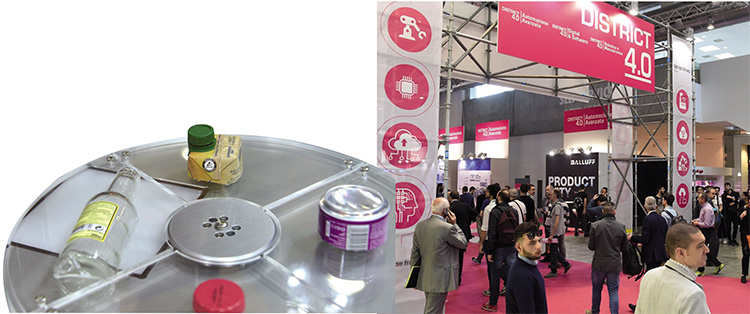
Large number of visitors for the recent edition of SPS Italia, organized in Parma by Messe Frankfurt Italia: more than 41500 visitors in fact crowded the stands of the over 850 exhibitors from 28 to 30 May. Even the conferences, with about seventy meetings, contributed to the umpteenth success of the event, thanks to the current topics and workshops dedicated to new products and new solutions.
At this point, a premise is necessary: given that the innovations are above all in the field of Industry 4.0, their applicability has a more general character, ie they are not intended for a single industrial sector.
That is why, among the many innovations seen at the fair, for obvious reasons of space, we will present here those most associated with the packaging world.
Development trends: a summary
• The propensity of users to create customized products also reverberates with automation manufacturers, increasingly oriented to develop ad hoc solutions for machine builders.
• Another trend is the impetuous development of software (which we will discuss in a future article, Ed.), especially of the "apps", now made available to customers by practically all suppliers, dedicated to predictive maintenance and plant monitoring but not only that.
• When it comes to maintenance and monitoring, sensors come into play, which sees the development of intelligent sensors that can be connected to standard now universally accepted I/OLink networks.
• Still with regard to sensors, we take a glance at vision systems: ever smaller, ever more powerful and increasingly integrated with motion controllers, PLCs, all programmable with a single software suite.
• As regards vision systems, they are applied, as is well known, not only in quality control and handling, but now also in the safety of robots. Collaborative robots are in fact kept under control by a vision system developed ad hoc, which prevents them from accessing the area where man is present.
We are talking again, for example, about shooting from a pile thanks to the use of vision and artificial intelligence systems.
• A final consideration on safety: the safety&security binomial is now becoming inseparable. This fact is attributable to the activism of hackers who, by targeting installations (and not only), cause damage not only things but also - and to a heavy extent - people.
And at the fair it has been emphasized on several occasions how the indispensable actions for protection (updates of operating systems using the most up-to-date anti-intrusion software, insurance contracts designed specifically for the company ...) are often not undertaken, with serious damage for affected companies.

SENSORS, VISION SYSTEMS, READERS, CONTROLS: AN OVERVIEW
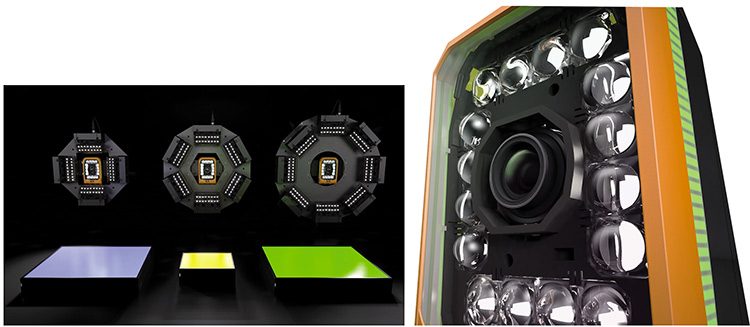
• Fully integrated machine vision system. B&R vision systems include two different cameras: Smart Sensor and Smart Camera, respectively for one or more simultaneous functions.
Since the hardware is fully integrated into the automation system, the cameras - and the illuminators, in any configuration - can be synchronized to the machine's functions with microsecond precision. The result is the optimal image in any ambient lighting condition even at high speeds, guaranteeing quality productions without penalizing productivity.
Three the image sensors from 1.3 to 5 Mpixels available, all characterized by large pixels, and a high signal-to-noise ratio. The lighting is integrated and synchronized with the cameras, and is optionally in the form of LEDs incorporated in the camera housing or in external LED bars, modular and adjustable or, again, in panels for backlighting.
The cameras are available with integrated lens or with a standard C-mount; the integrated lenses, with focal lengths from 4.6 to 25 mm, are equipped with electronic adjustment of focus.
The cameras connect to the machine's network via a single cable (with M12 hybrid connector) which also provides the necessary 24 V power supply. A second hybrid connection allows easy daisy-chaining with additional cameras or B&R illuminators.

 • The 3D camera makes the cobot more secure. For robots, but especially for cobots (collaborative robots), the detection of objects and people in their direct environment is particularly important. The cobot can move independently and reliably only if a three-dimensional image of the immediately surrounding environment is made available to its control system.
• The 3D camera makes the cobot more secure. For robots, but especially for cobots (collaborative robots), the detection of objects and people in their direct environment is particularly important. The cobot can move independently and reliably only if a three-dimensional image of the immediately surrounding environment is made available to its control system.
For this type of application in industrial environments, Ifm now offers the new 3D O3X camera, with ToF technology which, in turn, is based on the measurement of the flight time of the light between camera and object. The technology was developed by Pmd technologies, a subsidiary of Ifm, and is used, among others, in Lenovo and Asus smartphones.
The O3X has a resolution of 224 x 172 pixels and a repetition rate of 20 Hz and can detect objects up to 4 m apart.
Since the operation takes place with infrared light, the camera is not sensitive to ambient light and is independent of lighting. The 3D image data is provided via the integrated Ethernet interface. Windows SDK, Linux Lib and the active support of the ROS robot operating system on GitHub facilitate its rapid integration.
The camera is mounted inside an IP54 industrial housing the size of a matchbox.
Typical applications of the new O3X camera are autonomous moving robots for example in logistics applications.

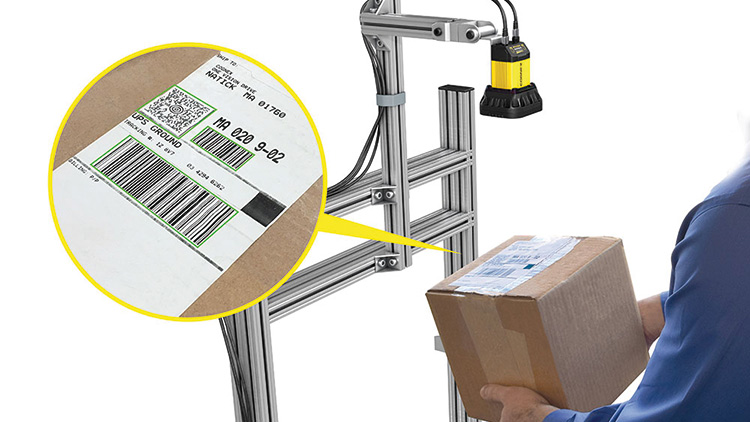
• High-speed barcode reader with fixed mounting and advanced lighting. The new DataMan 370 series of Cognex fixed-mount barcode readers doubles the computing power compared to traditional readers in its class.
DataMan 370 offers more efficient decoding speed to improve plant speed, even when applications need to detect more codes and symbologies.
The series uses the latest Cognex decoding algorithms to read 1D and 2D codes, handling print damage, blurred focus, low resolution and other real problems. These instruments are combined with high dynamic range (HDR) imaging technology for greater depth of field and better management of low contrast codes.
Finally, the new integrated lighting combines advanced autofocus technology with distance sensors to always guarantee the best image formation. Fast and reliable automatic tuning allows operators to configure new applications in seconds.
DataMan 370 shares the same light and lens options as the DataMan 360 and 470 series, allowing technological updates without interruption. The new series is easy to install and features an intuitive user interface and real-time process performance feedback.

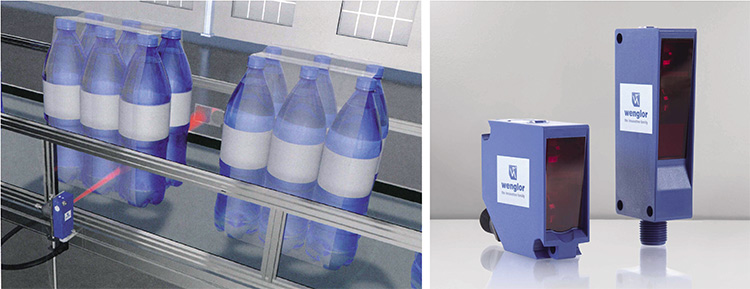
• A family of growing intelligent sensors. The two new PNG//smart series in 1N (75x32.5x18 mm) and 1P (50x50x20 mm) formats are the latest additions to Wenglor’s range of intelligent optoelectronic sensors. Easy to manage and able to communicate thanks to integrated IO-Link technology, the PNG//smart sensors have been designed for industry 4.0.
Equipped with the same technical features as the PNG//smart 1K models which are in miniaturized format (32x16x12 mm), the PNG//smart 1N and 1P feature innovative features such as the ability to integrate up to seven operating principles with two different light versions. blue and red: direct scanning with and without background suppression, high-performance distance with WinTec, reflex, reflective barrier with or without transparency recognition and unidirectional barrier and due to the multi-application nature.

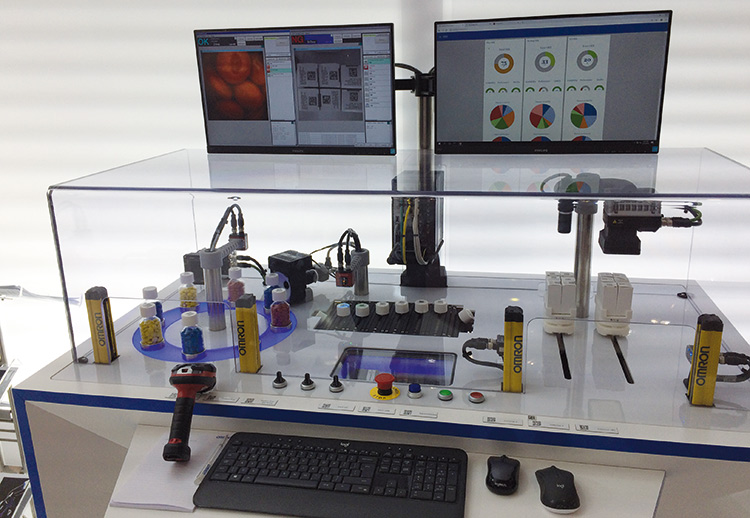
• Traceability and inspection to protect the brand. The ability to monitor products during the entire production process results in complete control, to the benefit of quality, reliability and performance. Starting from this assumption at SPS Omron showed a demo that integrated the various technologies in the catalog: from the basic code readers to the most intelligent vision systems for inspection which, in the demo, have been integrated with robots (even the mobile ones LD), with the IPC platform that manages the data flows provided by the Sysmac platform, with connectivity to plug and play databases. These are solutions widely used in the pharmaceutical and food sectors. The advantages for the producers? Cost reduction, structural improvements in "just in time" deliveries, inventory reduction, predictive maintenance and quality control.
With traceability and inspection manufacturers can protect their brands, improve overall equipment efficiency (OEE), be ready for increasingly stringent regulations and respond flexibly to growing supply chain needs.


• Position sensors with magnetostrictive technology. Gefran's Hyperwave is a new range of high performance magnetostrictive technology position sensors, with a 0.01 mm signal read repeatability, a non-linearity error of 0.01%/FS and a stroke of up to 4.000 mm. The amplification of the primary element signal, 15 times higher than traditional models, makes it immune to electromagnetic fields, guaranteeing precise and continuous operation over time. The range consists of two series: WP (Profile Magnetostrictive Position Transducer) with profile mechanics for mounting by brackets directly on the structure to be measured and WR (Rod-style Magnetostrictive Position Transducer) with 10 mm AISI 316L stainless steel shaft mechanism.

 • Safety laser scanner. After the recent launch of the stand-alone SLS-SA5 model, Datalogic now offers an even more complete solution, aimed at monitoring applications for single and multiple safety areas, capable of managing both horizontal and vertical static applications (such as robot cells, protection perimetral machine tools and work centers or protection of access passages, etc.) and dynamic (forklifts and simple automatic guided carriages).
• Safety laser scanner. After the recent launch of the stand-alone SLS-SA5 model, Datalogic now offers an even more complete solution, aimed at monitoring applications for single and multiple safety areas, capable of managing both horizontal and vertical static applications (such as robot cells, protection perimetral machine tools and work centers or protection of access passages, etc.) and dynamic (forklifts and simple automatic guided carriages).
Using the Master and Slave models, up to 4 Sentinel Lasers can be connected together, communicating with each other on an Ethernet basis. The slaves are connected to the master with a single cable which also supplies them with power. The synchronization of the four scanners is an integrated and dynamic function; no external control units are required.
By choosing Safety Laser Scanners users can benefit from several advantages including: fewer cables, saving on safety modules or safety inputs on the PLC, easy installation, simplified maintenance and above all improving productivity.

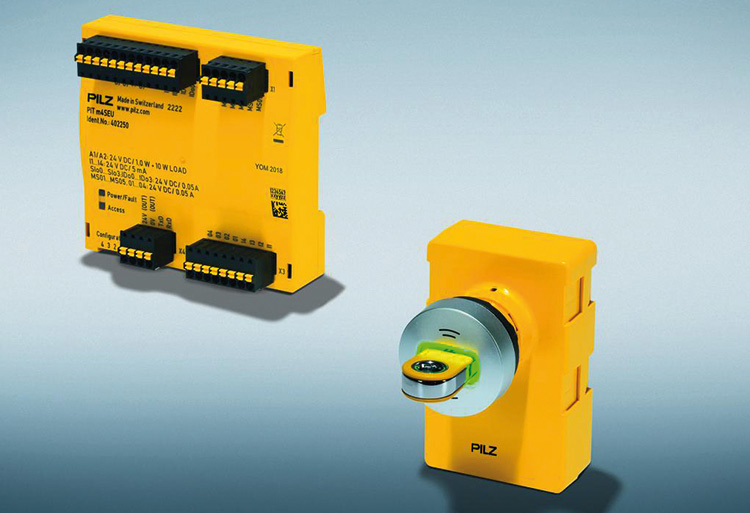
Merger of safety and security functions
A simple mention of Pilz's new PITmode fusion, which is widely spoken in the article "Where safety (& security) is heading". It is a modular system for managing access authorization and selecting the operating mode. The system consists of the PITreader reading unit with RFID technology, integrated web server and the Safe Evaluation Unit (SEU) control unit.

 • No fieldbus needed! The new Preventa XPS Universal relay safety modules from Schneider Electric combine the ease of application of wired safety modules with complete diagnostics - features that in the past required the use of the most complex and expensive fieldbus technologies. With a simple point-to-point connection, by connecting the module signaling output to the machine PLC digital input, it is possible to send over forty status and/or error messages.
• No fieldbus needed! The new Preventa XPS Universal relay safety modules from Schneider Electric combine the ease of application of wired safety modules with complete diagnostics - features that in the past required the use of the most complex and expensive fieldbus technologies. With a simple point-to-point connection, by connecting the module signaling output to the machine PLC digital input, it is possible to send over forty status and/or error messages.
Moreover, thanks to the smart signaling output of the XPSU module, it is possible to process the test cycles performed and the number of operations remaining, before the end of life, for all functional safety components.
How do they work? Preventa XPS Universal safety modules send modulated signals to the machine controller; through two function blocks in the PLC, diagnostics and predictive maintenance, it is possible to decode the signals and carry out a complete diagnostics. A function block library is available for all the most common PLC programming software on the market as well as those of Schneider.
These modules are simple to use, because the integration with the machine controller is still based on wired connections and does not need a fieldbus.
The selection of the functions is done manually with a screwdriver, using the rotary switches on the front: the same module can be used for more safety functions, simplifying the management of spare parts and documentation.
Also for the Preventa XPS Universal range, as for the Schneider safety components, certified Safety Chain solutions are available, these are application examples of safety functions in which the architecture, the scheme and the evaluation of the Performance Level are defined.


• Higher performance engines for more intelligent systems. The new line of Sick smart motor sensors consists of motor feedbacks that use Hiperface dsl, the protocol developed by the Turin branch for the world of servo drives. The sensors monitor not only the motors in real time, but the entire system. The data collected concern position, temperature in the engine and the surrounding area, speed, vibrations, constant voltage and cycles. The information is displayed through histograms generated every minute, monitoring the status of the system for predictive maintenance. All with a single cable.
EDx35 is the latest in the family, it is a digital motor feedback system available in both SingleTurn and MultiTurn versions for synchro size 40 motors. Among the many features we point out: the resolution of 24 bits, the absence of a buffer battery, the transmission of absolute position - speed - acceleration every 12µs.
Furthermore, the storage takes place automatically in the EEprom every 20 min with control histograms. The sensor, very compact, thanks to the different sizes in which it is available, can also be used in stand alone applications.
Thanks to the Hiperface DSL protocol, wiring is simple and fast: for commissioning just two cables inserted in the single power connector mounted in the motor. The protocol is already ready for the Safety SIL2 and SIL3 levels as far as the position is concerned.

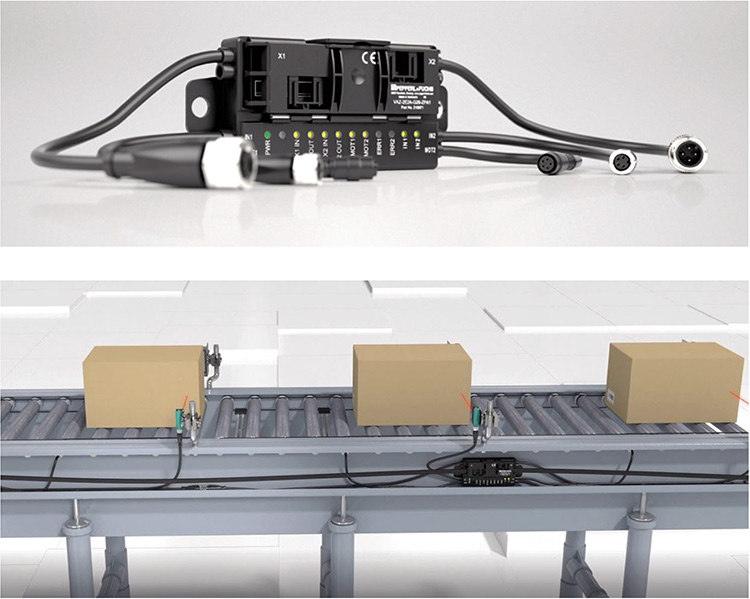
The conveyor rollers only work when necessary
The G20 ZPA module from Pepperl+Fuchs is easy to integrate as no special tools are needed and the module's swivel mechanism facilitates repositioning, allowing the construction of modular, immediately-operational roller conveyors. All the necessary doors are integrated in the thin module, which can easily be fixed to the mounting rail.
The integrated logic allows rapid commissioning and automatic proximity detection, including the control of connected motors without the need for special or programming devices.
Through three rotary selectors, the speed and direction of rotation and one of the seven operating modes are determined. It is also possible to use an optional ZPA analyzer for commissioning and diagnostics, which automatically generates a list of all the devices with their settings.
The new module addresses the rollers only if necessary, otherwise, the rollers are placed in "suspension mode", thus allowing to reduce energy costs. At the same time, five start and stop ramps ensure a gradual acceleration and deceleration of the conveyor belts, protecting the roller gears in the long term. The module works independently of the fieldbus and allows integration up to a maximum of 256 modules in series.











